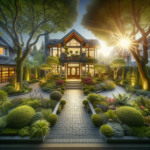[ad_1]
Embracing Sustainable Landscaping: The Beauty of Ant Rattan
In recent years, there has been a growing trend towards embracing sustainable practices in all aspects of life, and landscaping is no exception. One of the key components of sustainable landscaping is the use of natural, eco-friendly materials that not only enhance the beauty of outdoor spaces but also have a minimal impact on the environment. One such material that is gaining popularity for sustainable landscaping is Ant Rattan.
What is Ant Rattan?
Ant Rattan, also known as Myrmecodia, is a unique and versatile plant that belongs to the epiphytic family. It is native to the rainforests of Southeast Asia, particularly Indonesia and Papua New Guinea. The plant is known for its bulbous, swollen base which forms a natural water reservoir, enabling it to survive in the wild by storing water and nutrients. Its unique structure and aesthetic appeal make it an excellent choice for sustainable landscaping.
Caring for Ant Rattan
When it comes to caring for Ant Rattan, maintaining the plant is relatively simple. Ant Rattan thrives in warm, humid conditions and prefers indirect sunlight. It is essential to provide the plant with a well-draining potting mix and to water it regularly, ensuring that the soil stays moist but not waterlogged. In the wild, Ant Rattan forms symbiotic relationships with ants that help protect and feed the plant. While it is not necessary to have ants in your home garden, they can be beneficial if they do establish a presence as they can help keep the plant pest-free. With proper care and maintenance, Ant Rattan can thrive for many years, adding a unique and natural element to your sustainable landscape.
Sourcing Ant Rattan
When sourcing Ant Rattan for landscaping purposes, it is essential to ensure that you are purchasing from a reputable and sustainable source. It is important to choose plants that have been responsibly harvested or propagated, ideally from a nursery or supplier specializing in sustainable and ethically sourced plants. By doing so, it ensures that the natural habitats and ecosystems where Ant Rattan grows are not compromised. Additionally, purchasing Ant Rattan from sustainable sources helps support local communities and promotes the conservation of these unique and valuable plant species.
How to Best Use Ant Rattan in Landscaping
Ant Rattan is a versatile and visually striking plant that can be used in a variety of landscaping applications. Here are some ways in which you can incorporate Ant Rattan into your sustainable landscape design:
1. Vertical Gardens: Ant Rattan’s unique bulbous base and trailing foliage make it an excellent choice for vertical gardens. It can be grown in hanging baskets or mounted on a vertical structure, creating a stunning display of greenery that adds visual interest to any outdoor space.
2. Tropical Landscapes: Ant Rattan is well-suited for tropical and exotic landscape designs. Its natural habitat in the rainforests of Southeast Asia makes it an ideal choice for creating a lush and vibrant tropical garden. Pair it with other tropical plants and foliage to create a cohesive and visually appealing landscape.
3. Container Gardens: Ant Rattan can be grown in containers, making it a versatile option for small outdoor spaces such as patios and balconies. Placing Ant Rattan in decorative pots or containers allows you to create a stunning focal point while adding a touch of natural beauty to your outdoor living areas.
4. Living Walls: Ant Rattan can be incorporated into living walls, also known as green walls, to create a living, breathing work of art. Its trailing foliage and unique structure add depth and texture to living wall designs, transforming ordinary walls into vertical gardens that are both eye-catching and environmentally friendly.
5. Edible Landscapes: In addition to its aesthetic appeal, Ant Rattan also produces edible fruits. While not as commonly used for this purpose, incorporating Ant Rattan into edible landscapes can add a unique and sustainable element to your garden. Harvest the fruits when they ripen and enjoy a taste of the tropics right in your own backyard.
Benefits of Using Ant Rattan in Sustainable Landscaping
There are numerous benefits to using Ant Rattan in sustainable landscaping. Here are just a few:
1. Low Maintenance: Ant Rattan requires minimal maintenance, making it an excellent choice for busy homeowners or those who prefer low-maintenance landscaping. With the right care, Ant Rattan can thrive for many years with little effort.
2. Drought Tolerant: Ant Rattan’s natural water reservoir allows it to survive periods of drought, making it a resilient and sustainable choice for water-wise landscaping.
3. Biodiversity: By incorporating Ant Rattan into your landscape design, you are supporting biodiversity and promoting the conservation of a unique and valuable plant species.
4. Aesthetic Appeal: Ant Rattan adds a touch of natural beauty to outdoor spaces, creating a visually stunning and environmentally friendly landscape.
5. Eco-Friendly: Using Ant Rattan in your landscaping promotes sustainable practices and reduces the environmental impact of traditional landscaping materials. By choosing natural and eco-friendly materials like Ant Rattan, you are contributing to a healthier and more sustainable planet.
In conclusion, embracing sustainable landscaping is an essential step towards reducing the environmental impact of outdoor spaces and promoting the conservation of natural habitats. Ant Rattan is a unique and versatile plant that offers numerous benefits for sustainable landscaping, from its low maintenance and drought-tolerant qualities to its aesthetic appeal and support for biodiversity. By sourcing Ant Rattan from reputable and sustainable sources and incorporating it into your landscape design, you can create a visually stunning and environmentally friendly outdoor space that enhances the beauty of your surroundings while minimizing your ecological footprint. Consider embracing Ant Rattan in your sustainable landscaping efforts and discover the natural beauty and sustainability it brings to your outdoor spaces.
[ad_2]




